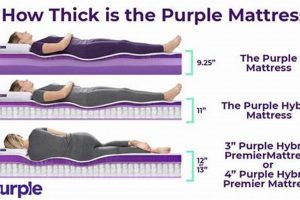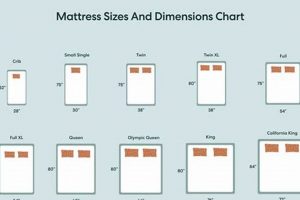The dimensions of a camper queen sleeping surface typically measure around 60 inches in width and 75-80 inches in length. This configuration offers a balance between space efficiency within the confined area of a recreational vehicle and providing adequate sleeping space for two adults. These measurements can vary slightly depending on the manufacturer and specific RV model.
Selecting a bed of this dimension allows for comfortable accommodation in a motorhome or travel trailer without sacrificing valuable living space. Its utilization maximizes floor area, enabling easier movement and storage. Historically, these sizes have evolved to accommodate both the increasing demand for comfort and the limitations of RV design.
Understanding these dimensions is crucial when selecting bedding and linens specifically designed for RV use. The following sections will further explore the practical considerations for selecting and maintaining a comfortable sleep system in a camper setting.
Tips on Selecting a Camper Queen Mattress
Proper selection and maintenance are essential for ensuring restful sleep while traveling. The following tips outline key considerations for maximizing comfort and extending the lifespan of a camper queen sleeping surface.
Tip 1: Measure Accurately. Before purchasing any replacement, verify the existing dimensions of the sleeping platform within the camper. Minor variations can lead to significant fitment issues. A precise measurement ensures proper accommodation within the designated space.
Tip 2: Consider Foam Density. Higher density foam provides greater support and durability, particularly for prolonged use. Lower density foam compresses more easily, potentially leading to discomfort and a shorter lifespan. Evaluate the weight capacity and expected usage frequency when determining the appropriate density.
Tip 3: Evaluate Thickness. The overall thickness contributes significantly to comfort. A thicker profile generally offers enhanced cushioning and support. However, consider vertical space limitations within the camper, particularly in overhead bunk configurations.
Tip 4: Research Material Options. Memory foam contours to the body, providing pressure relief. Latex offers a more resilient and breathable surface. Innerspring constructions provide a firmer feel with enhanced support. Carefully weigh the properties of each material to align with individual sleep preferences.
Tip 5: Investigate Cover Fabrics. The outer cover plays a crucial role in regulating temperature and moisture. Breathable fabrics like cotton or bamboo promote airflow, minimizing heat retention and enhancing comfort. Antimicrobial treatments can inhibit the growth of bacteria and mold, promoting hygiene.
Tip 6: Prioritize Proper Support. Adequate support prevents sagging and promotes spinal alignment. Insufficient support can lead to discomfort and potential back pain. Ensure that the chosen unit provides the necessary level of firmness and stability.
Tip 7: Consider Weight. A lighter option reduces the overall weight of the camper, potentially improving fuel efficiency. Excessive weight can also strain the vehicle’s suspension. Prioritize lightweight materials without compromising on comfort or durability.
Adhering to these guidelines can significantly enhance the sleep experience while camping, contributing to overall well-being and enjoyment of the travel experience. Careful consideration of these factors ensures a comfortable and supportive sleeping surface.
The subsequent section will address cleaning and care recommendations for preserving the integrity and extending the lifespan of the camper queen mattress.
1. Width specification
The width specification is a primary determinant in defining the size of a camper queen sleeping surface. Typically standardized at 60 inches, this dimension directly influences the usability and comfort offered within the confined space of a recreational vehicle. A precise adherence to this measurement allows manufacturers to optimize internal layouts, balancing sleeping accommodations with other essential amenities. Deviations from this standard can lead to incompatibility with existing RV platforms and discomfort for occupants. For instance, a width marginally narrower than specified might result in instability, while an excessive width prevents proper installation, rendering the unit unusable.
The significance of a standardized width extends beyond mere fitment. Bedding manufacturers design sheets, blankets, and mattress protectors specifically for this common dimension. Consequently, a standardized width specification simplifies the acquisition of correctly sized accessories, ensuring a seamless integration into the RV living space. Furthermore, the 60-inch width has been empirically determined to accommodate two adults comfortably, contributing to the functional efficiency of camper designs. Its selection has become a design choice based on both practical considerations and user expectation for comfort.
Therefore, the width specification constitutes a foundational element in determining the overall size characteristics. Its adherence to a standard measurement, 60 inches for a camper queen, is not merely arbitrary but is driven by functional necessity, compatibility with accessories, and ergonomic considerations. Variations can introduce significant usability challenges and negatively impact the overall recreational vehicle experience. The width specification is therefore, important when considering the size of camper queen mattress.
2. Length variation
The length variation in a camper queen unit directly impacts the overall size and suitability for specific recreational vehicle models. While the standard width remains consistent, the length may fluctuate between 75 and 80 inches. This five-inch difference addresses diverse spatial constraints within RV interiors. A shorter length (75 inches) might be preferred in compact campers where space is at a premium, preventing obstruction of walkways or other functionalities. Conversely, an 80-inch length offers greater sleeping surface for taller individuals, maximizing comfort and minimizing potential discomfort due to restricted legroom. Failure to account for this variance can result in a unit that does not properly fit within the designated area or compromises occupant comfort.
Choosing the appropriate length requires careful consideration of both the available space and the height of intended users. An incorrectly sized unit may necessitate modifications to the RV interior, incurring additional costs and time. Furthermore, the availability of appropriately sized bedding can be influenced by the length. While standard queen-sized sheets can often be adapted, fitted sheets and protectors might require specialized sourcing for the shorter 75-inch variant. Therefore, determining the ideal length variation is a crucial step in selecting a camper queen mattress, ensuring both physical fit and comfortable use.
In summary, the length variation is a significant component of overall dimensions, directly influencing compatibility and user experience. Selecting the appropriate length demands meticulous assessment of available space and occupant height. Overlooking this specification can lead to fitment problems, compromise comfort, and introduce unnecessary expense. Careful attention to length variation contributes to optimal integration and enhanced usability within the recreational vehicle. This careful attention to detail further emphasizes that both the length and width dimension help determine the size of camper queen mattress.
3. Thickness options
Thickness is a critical dimension when considering the overall size and comfort characteristics of a camper queen mattress. While width and length define the surface area, thickness determines the level of support, cushioning, and overall profile within the limited space of a recreational vehicle.
- Impact on Comfort and Support
A greater thickness typically translates to increased cushioning and improved support, particularly when utilizing materials like memory foam or latex. Thicker mattresses can better distribute weight, alleviating pressure points and promoting spinal alignment. This is particularly relevant for extended travel, where consistent, restful sleep is paramount for well-being and safe operation of the vehicle.
- Space Constraints and Overhead Clearance
Thickness considerations must be balanced against spatial constraints within the camper. Excessive thickness can reduce headroom, particularly in overhead bunks or areas with low ceilings. Selecting an overly thick unit can create an uncomfortable and claustrophobic sleeping environment, negatively impacting the overall RV experience. Accurate measurements and careful planning are essential to avoid these issues.
- Weight Implications
Generally, a greater thickness corresponds to increased weight. The additional material contributes to the overall mass of the mattress, which can impact fuel efficiency and place additional strain on the vehicle’s suspension system. When choosing a thickness, prioritize materials that offer a balance between comfort, support, and weight. Lighter materials may allow for a thicker profile without significantly increasing the overall weight of the unit.
- Bedding Compatibility
The thickness influences the type of bedding required. Standard-sized sheets may not adequately fit overly thick mattresses, necessitating the purchase of deep-pocketed sheets. This adds to the overall cost and may limit the availability of preferred bedding options. Prior to selecting a thickness, assess the compatibility with existing or easily obtainable bedding to ensure a hassle-free setup.
In conclusion, the mattress thickness plays a crucial role in determining the overall size and suitability within a camper. The optimal thickness requires a careful balancing act between comfort, spatial limitations, weight considerations, and bedding compatibility. A thorough assessment of these factors ensures a comfortable and practical sleep solution for recreational vehicle travel.
4. Weight consideration
The weight associated with a camper queen sleeping surface is a direct consequence of its dimensions and materials. As dimensions increase, the mass of the materials required to fill that volume also increases, leading to a heavier mattress. This correlation necessitates careful evaluation, as excessive weight can negatively impact the recreational vehicle’s fuel efficiency, handling characteristics, and overall structural integrity. For example, a larger, thicker memory foam unit, while offering enhanced comfort, may significantly increase the vehicle’s gross weight, potentially exceeding its load capacity. Therefore, weight becomes an integral component when considering the size of a camper queen mattress, forcing a trade-off between comfort and practicality.
Real-world examples illustrate the practical significance of this understanding. Campers who prioritize lightweight materials, such as thinner foam constructions or air mattresses, often do so to maximize fuel economy and minimize wear on their vehicle’s suspension. Conversely, individuals willing to accept a weight penalty might opt for thicker, denser mattresses to achieve a more luxurious sleep experience. This decision hinges on the specific vehicle’s capabilities and the owner’s priorities. Furthermore, the placement of the sleeping surface within the RV also influences the impact of weight. Mattresses positioned high up, like in overhead bunks, can affect the vehicle’s center of gravity more significantly than those located lower down.
In summary, the relationship between weight and dimensions is a critical consideration when selecting a camper queen mattress. Overlooking weight implications can lead to decreased fuel efficiency, compromised handling, and potential damage to the vehicle. Achieving an optimal balance between dimensions, materials, and weight is essential for a safe and comfortable RV travel experience. Future innovations in lightweight materials and construction techniques may mitigate these challenges, allowing for larger, more comfortable mattresses without sacrificing vehicle performance.
5. Corner radius
The corner radius, in the context of a camper queen sleeping surface, refers to the curvature applied to the corners of the mattress. While not universally present, corner radius becomes a relevant dimensional factor when the sleeping platform or surrounding structure within the recreational vehicle incorporates a similar curvature. The size of the camper queen mattress, therefore, necessitates consideration of the corner radius to ensure a proper fit. A mismatch between the radius of the mattress and the platform can lead to unusable gaps, instability, and accelerated wear on the edges. Examples are often found in teardrop trailers or vintage campers where curved walls and furniture are integral design elements. The corner radius then directly influences the effective usable sleeping area and impacts overall comfort.
Consider a camper queen mattress with sharp, right-angled corners placed in a sleeping area designed with rounded corners. The sharp corners protrude, creating a potential hazard and preventing the mattress from fully seating against the surrounding structure. Conversely, a mattress with a significant corner radius placed in a square frame leaves unusable gaps, reducing the sleeping surface and potentially causing the mattress to shift during use. Manufacturers sometimes offer custom mattress options with specified corner radii to accommodate such non-standard configurations. Ignoring the corner radius in these circumstances compromises the intended functionality and aesthetic of the recreational vehicle.
In summary, although often overlooked, corner radius can be a critical dimension when determining the suitability of a camper queen mattress for certain recreational vehicle designs. A proper match between the mattress corner radius and the surrounding structure ensures optimal fit, stability, and usable sleeping area. When selecting a mattress, verifying the corner radius, or lack thereof, becomes essential in achieving a seamless and functional integration within the confined space of a camper. The corner radius plays a crucial role in determining the precise fit and overall functionality. Therefore, corner radius affects size of camper queen mattress.
6. Platform compatibility
Platform compatibility represents a critical factor directly contingent upon the dimensions of a camper queen sleeping surface. The dimensions (width, length, and thickness) must align precisely with the supporting structure within the recreational vehicle. Discrepancies between these dimensions result in instability, uneven support, and potential damage to both the platform and the mattress itself. The size of a camper queen mattress, therefore, is inherently defined by the constraints of its intended platform. Real-world examples include instances where an oversized mattress overhangs the edges of the platform, creating a tripping hazard and accelerating wear along the unsupported edges. Conversely, an undersized mattress shifts during use, leading to discomfort and potential damage to the platform structure. The practical significance of this understanding lies in the prevention of premature wear and the maintenance of a safe and comfortable sleeping environment.
Further analysis reveals the impact of platform construction materials on mattress selection. Slatted platforms, for instance, require a mattress of sufficient thickness and firmness to prevent sagging between the slats. Solid platforms, on the other hand, offer more uniform support and allow for greater flexibility in mattress selection. The design of the platform’s edges also influences compatibility. Raised edges necessitate careful measurement of the mattress thickness to ensure proper fitment within the frame. Similarly, recessed platforms require precise dimensioning to prevent the mattress from shifting during use. These practical applications emphasize the importance of considering platform construction materials and edge design when selecting the appropriate size of a camper queen sleeping surface.
In conclusion, platform compatibility is inextricably linked to the size of a camper queen mattress. The proper alignment of dimensions ensures stability, prevents damage, and contributes to a safe and comfortable sleeping environment. Challenges arise when dealing with non-standard platforms or custom-built recreational vehicles, necessitating precise measurements and potentially customized mattress solutions. Understanding this connection is paramount for optimizing the functionality and longevity of both the mattress and the supporting structure. Therefore, platform compatibility further defines size of camper queen mattress.
Frequently Asked Questions
The following addresses common inquiries concerning the size specifications and practical considerations associated with camper queen sleeping surfaces. This information aims to provide clarity on the dimensions and their implications for recreational vehicle use.
Question 1: What are the standard dimensions of a camper queen mattress?
The typical dimensions approximate 60 inches in width and 75-80 inches in length. Thickness can vary depending on material and construction. These measurements facilitate fitment within the constraints of recreational vehicles.
Question 2: Why does the length of a camper queen mattress vary?
Length variations, typically between 75 and 80 inches, accommodate diverse spatial configurations within campers. Shorter lengths optimize space in compact models, while longer lengths provide increased comfort for taller individuals.
Question 3: How does mattress thickness impact comfort and space?
Thickness influences cushioning and support. However, excessive thickness can reduce headroom, particularly in overhead bunks. Careful consideration of spatial limitations is essential to avoid an uncomfortable sleeping environment.
Question 4: Does the weight of a camper queen mattress matter?
Weight is a critical factor. A heavier mattress can negatively impact fuel efficiency and place additional strain on the vehicle’s suspension. Lighter materials contribute to improved vehicle performance.
Question 5: What is corner radius, and why is it important?
Corner radius refers to the curvature of the mattress corners. This is relevant if the sleeping platform incorporates rounded corners. A proper match ensures stability and prevents unusable gaps. Ignoring it results in poor fitment.
Question 6: How does platform compatibility relate to the size?
Platform compatibility necessitates that the mattress dimensions align precisely with the supporting structure. Discrepancies can lead to instability, uneven support, and potential damage. The intended platform constrains the size.
Understanding the dimensions of a camper queen sleeping surface requires consideration of width, length, thickness, weight, corner radius, and platform compatibility. Accurate measurements and thoughtful planning contribute to a safe and comfortable recreational vehicle experience.
The subsequent section will explore the process of selecting a replacement mattress, outlining key factors to consider during the purchasing process.
Conclusion
This exploration of the dimensions inherent in a camper queen sleeping surface has underscored the critical interplay between width, length, thickness, weight, corner radius, and platform compatibility. The analysis has revealed that the seemingly simple term “size of camper queen mattress” encompasses a complex set of considerations that directly impact comfort, safety, and the overall functionality of a recreational vehicle.
Therefore, careful attention to these dimensional factors is not merely a matter of preference, but a necessity for ensuring a well-integrated and optimized travel experience. Further research and advancements in material science may offer improved solutions, but the principles outlined herein remain foundational for making informed decisions regarding sleeping accommodations within the confined space of a camper.


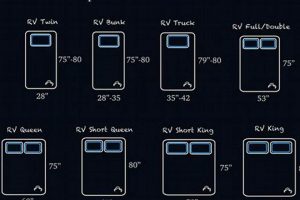
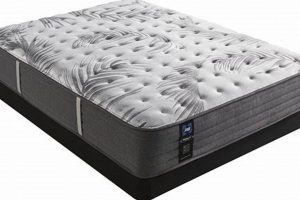
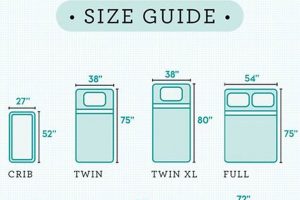
![Best Queen Size Foldable Mattress [Guide] Organic & Natural Mattress Buyer’s Guide: Non-Toxic Sleep Solutions Best Queen Size Foldable Mattress [Guide] | Organic & Natural Mattress Buyer’s Guide: Non-Toxic Sleep Solutions](https://mattressworldpa.com/wp-content/uploads/2025/07/th-2272-300x200.jpg)
